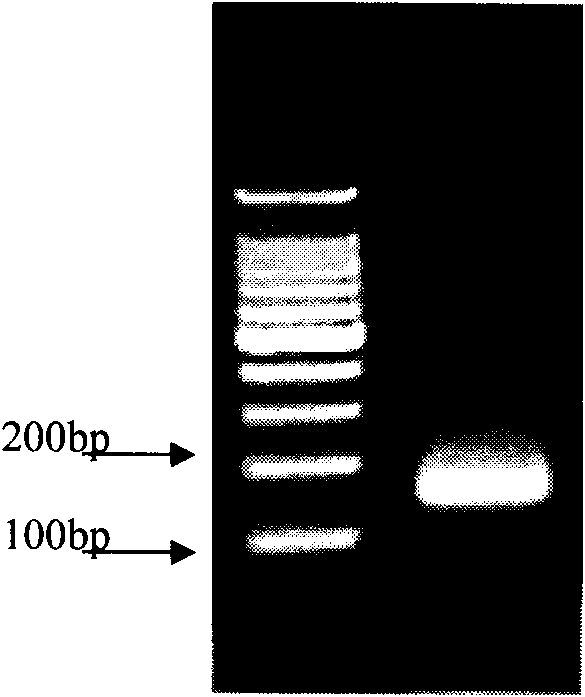Method for preparing human chromosome P16 gene probe and application thereof
A gene probe and chromosome technology, which is applied in the field of human chromosome P16 gene detection kits, can solve the problems of difficult, time-consuming, lack of systematic and mature methods for tumor cells, etc., and achieves good reproducibility of results, simple operation, and rapid detection. Effect
- Summary
- Abstract
- Description
- Claims
- Application Information
AI Technical Summary
Problems solved by technology
Method used
Image
Examples
Embodiment 1
[0036] Embodiment 1: the preparation method of human P16 gene probe
[0037] (1) Primer design and clone screening: The P16 gene is located on the 9p21 segment of human chromosome, and the clone containing this gene was selected: RP11-149I2.
[0038](2) Cloning culture and identification: purchase the corresponding clone Invitrogen RPCI11.C, take 50ul and add it to 500ml TB culture solution (chloramphenicol resistance), and shake the bacteria in a shaker at 37°C for 24-48 hours; the bacteria solution is used STS primer pair for clonal identification. STS primer pair: upstream primer 5'-ATCCAACATGCCATAGCTCC-3' and downstream primer 5'-TTTGTCCCATGTCACTGGAA-3', PCR amplification conditions: 95°C for 5 minutes; (94°C for 30 seconds, 56°C for 30 seconds, 72°C for 45 seconds )×40 cycles; 10 minutes at 72°C. The amplified product was verified by electrophoresis, and the result was a bright band around 184bp (see attached figure 1 ).
[0039] (3) Preparation of P16 gene probe: For...
Embodiment 2
[0057] Embodiment 2: Preparation of P16 gene detection kit
[0058] Take 10 servings / box as an example.
[0059] (1) Preparation of hybridization solution
[0060] Take a small amount of P16 gene probe and dilute it to 50ng / ul, and prepare the hybridization solution according to the following table:
[0061]
[0062] (2) DAPI counterstain preparation
[0063] Anti-fading solution: The whole process must be protected from light. Dissolve 10mg of p-phenylenediamine in 1ml of PBS, add 9ml of glycerin, shake and mix repeatedly, adjust the pH to 9.0, and store at -20°C. The final solution should be colorless or slightly yellowish. If yellow or orange appears, discard and reconstitute.
[0064] Prepare a 1mg / ml DAPI stock solution in deionized water.
[0065] Dissolve 2.5ul of DAPI solution (1mg / ml) in 1ml of anti-fading solution, shake and mix repeatedly in the dark, and store at -20°C in the dark.
[0066] (3) Finished product assembly
[0067] component name
...
Embodiment 3
[0069] Embodiment 3: the usage method of P16 gene detection kit
[0070] Take human normal dividing metaphase lymphocytes as an example.
[0071] (1) Human peripheral blood culture and chromosome preparation
[0072] Blood collection: After wetting the injection syringe (0.2ml) with heparin, take 1-2ml of venous blood routinely, and turn the syringe to mix the heparin. Inoculation (aseptic operation in ultra-clean workbench): In each culture bottle (5ml of 1640 culture solution containing 20% serum, pH7.2), add 0.25-0.30ml of whole blood (13-15 drops of No. 7 needle) , PHA 5mg, cover the rubber stopper tightly, and shake gently. Cultivation: Place the culture bottle in a constant temperature incubator at 37°C for 72 hours. 2-4 hours before terminating the culture, add 1-2 drops of 0.01% colchicine solution (100 μg / ml) (No. 7 needle), so that the final concentration is 0.2 μg / ml culture solution. After gently shaking, put it back into the incubator and continue culturing ...
PUM
 Login to View More
Login to View More Abstract
Description
Claims
Application Information
 Login to View More
Login to View More - Generate Ideas
- Intellectual Property
- Life Sciences
- Materials
- Tech Scout
- Unparalleled Data Quality
- Higher Quality Content
- 60% Fewer Hallucinations
Browse by: Latest US Patents, China's latest patents, Technical Efficacy Thesaurus, Application Domain, Technology Topic, Popular Technical Reports.
© 2025 PatSnap. All rights reserved.Legal|Privacy policy|Modern Slavery Act Transparency Statement|Sitemap|About US| Contact US: help@patsnap.com



